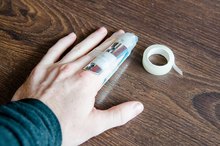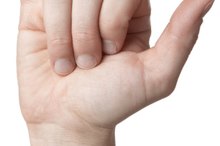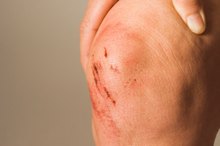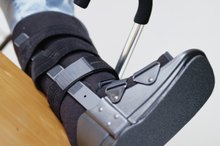When Can You Go Back to Normal Activities After a Broken Finger?
Since your finger has 14 bones, it may seem that a break in one shouldn't affect you much. But you need all of your finger bones in working order to carry out normal daily activities, from lifting a cup to your lips to writing a report. A broken finger -- medically termed a fracture -- can significantly affect your life, especially if it doesn't heal correctly. The type of break, area of the break and treatment all affect your recovery time. See your doctor promptly if you think you have a broken finger. Early treatment can prevent potentially permanent damage.
If you are experiencing serious medical symptoms, seek emergency treatment immediately.
Uncomplicated Fractures
Uncomplicated fractures heal faster and better than complicated fractures. With an uncomplicated fracture, the broken bones remain in alignment, meaning that they're still close enough to each other to heal back together. The break is clean, and the bone isn't shattered. Uncomplicated fractures do not break through the skin. An uncomplicated and properly treated finger fracture, immobilized so the two ends of bone can grow back together, usually heals within four to six weeks; small bones might heal within three weeks, according to an article in the April 2009 issue of "The University of Central Florida Undergraduate Research Journal." However, function of the finger, not the amount of time that has passed, determines whether you can return to normal activities. When the finger has full range of motion and the strength of an uninjured finger, without pain, you can use it normally.
- Uncomplicated fractures heal faster and better than complicated fractures.
- An uncomplicated and properly treated finger fracture, immobilized so the two ends of bone can grow back together, usually heals within four to six weeks; small bones might heal within three weeks, according to an article in the April 2009 issue of "The University of Central Florida Undergraduate Research Journal."
Complications
The Duration of a Broken Finger
Learn More
Complex fractures can take many forms. A bone that's in pieces or a break in which the two ends are no longer proximate might take longer to heal. A bone that breaks the skin increases the risk of developing an infection in the bone or severing a tendon or nerves, which could require surgical repair and several months of physical therapy. Complicated fractures will nearly always take longer than simple fractures to heal, but the amount of time will vary with the type of fracture and location.
- Complex fractures can take many forms.
- Complicated fractures will nearly always take longer than simple fractures to heal, but the amount of time will vary with the type of fracture and location.
Untreated Fractures
You might think that a sore finger will heal on its own and not seek medical treatment. This is a serious mistake, since fingers perform so many essential fine-motor functions. If the bones don't heal together well, you could develop a malunion, in which the bone grows back together but crookedly, or the tendons in the finger stick together or contract, becoming shorter and reducing your finger mobility, or other complications. Once the finger heals in the wrong position, correcting it could take considerably more time than the four to six weeks needed to heal it correctly in the first place. Do not attempt to heal a broken finger without medical intervention.
- You might think that a sore finger will heal on its own and not seek medical treatment.
- Once the finger heals in the wrong position, correcting it could take considerably more time than the four to six weeks needed to heal it correctly in the first place.
Considerations
What Causes Finger Joint Pain?
Learn More
Even with proper medical attention, you can develop complications from a broken finger. You might develop an infection in the bone if you had an open wound at the site of the break. Bone infections can take six to eight weeks of antibiotic treatment to heal, according to the American Academy of Orthopaedic Surgeons 14. If you have severe tendon damage, you might need surgery to repair a torn tendon in addition to treatment of the broken finger. Some damage might be permanent, meaning that you might never be able to perform some of the tasks you did before the break without intensive physical therapy, if then. Damage to the finger joint could cause debilitating arthritis in your fingers, particularly in the elderly, who are more likely to already have osteoarthritis. Seeing your doctor and following his instructions helps prevent long-term complications.
- Even with proper medical attention, you can develop complications from a broken finger.
- If you have severe tendon damage, you might need surgery to repair a torn tendon in addition to treatment of the broken finger.
Related Articles
References
- American Academy of Orthopaedic Surgeons: Fracture of the Finger
- The University of Central Florida Undergraduate Research Journal: Multiple Complications From a Finger Fracture in a Basketball Player: A Case Study With Implications for the Sports Medicine Practitioner
- American Academy of Orthopaedic Surgery: Infections After Fracture
- SUNY Upstate Medical Library: Finger Fractures
- Hospital for Special Surgery: Sports Injuries of the Hands
- Oetgen ME, Dodds SD. Non-operative treatment of common finger injuries. Curr Rev Musculoskelet Med. 2008;1(2):97-102. doi: 10.1007/s12178-007-9014-z.
- Borchers JR & Best TM. Common finger fractures and dislocations. American Family Physician. 2012 Apr 15;85(8):805-10.
- Haase SC, Chung KC. Current concepts in treatment of fracture-dislocations of the proximal interphalangeal joint. Plast Reconstr Surg. 2014;134(6):1246-57. doi:10.1097/PRS.0000000000000854.
- Won SH, Lee S, Chung CY, et al. Buddy taping: is it a safe method for treatment of finger and toe injuries?. Clin Orthop Surg. 2014;6(1):26-31. doi:10.4055/cios.2014.6.1.26.
- Cheung K, Hatchell A, Thoma A. Approach to traumatic hand injuries for primary care physicians. Can Fam Physician. 2013;59(6):614-8.
- Boyer JS, London DA, Stepan JG, Goldfarb CA. Pediatric proximal phalanx fractures: outcomes and complications after the surgical treatment of displaced fractures. J Pediatr Orthop. 2015;35(3):219-23. doi:10.1097/BPO.0000000000000253.
- Cheah AE, Yao J. "Hand Fractures: Indications, the Tried and True and New Innovations" J Hand Surg Am. 2016 Jun;41(6):712-22.
Writer Bio
A registered nurse with more than 25 years of experience in oncology, labor/delivery, neonatal intensive care, infertility and ophthalmology, Sharon Perkins has also coauthored and edited numerous health books for the Wiley "Dummies" series. Perkins also has extensive experience working in home health with medically fragile pediatric patients.









